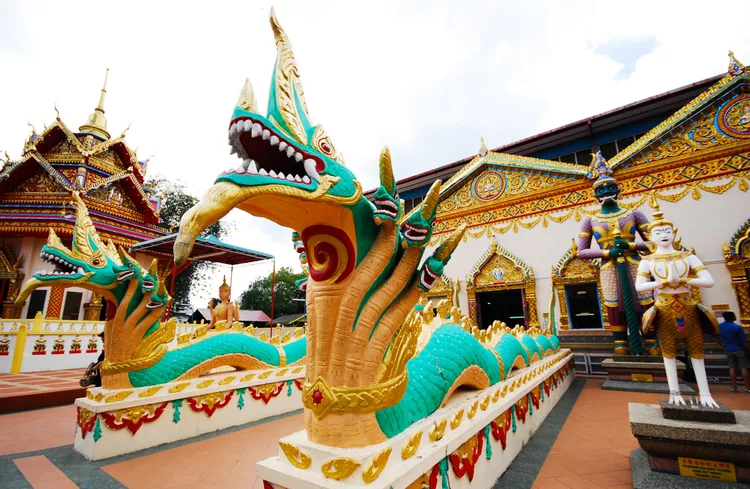Summary
Penang’s past as a British colonial holding and its present-day status as one of Malaysia’s most prosperous states have made it one of Southeast Asia’s most popular tourist stops. Nicknamed “the pearl of the Orient,” Penang possesses a multifaceted culture and eclectic cuisine that rewards adventurous travelers.
Located in the northern part of peninsular Malaysia, the island of Penang was first colonized in 1786 by British adventurer Captain Francis Light. Always looking for new opportunities for his employer the British East India Company, Captain Light saw in Penang a magnificent harbor for tea and opium transshipments between China and the rest of the British Empire.
Penang underwent a number of political transformations after Light wrested control from the local Malay royalty. It was incorporated into the British Straits Settlements, then became part of the Malayan Union, finally joining an independent Malaysia in 1957. Nonetheless, its long history under the British left an indelible mark: the capital of George Town retains an ineffable Imperial atmosphere that distinguishes it from Malaysia’s other grand cities.
First Stop: George Town, Penang
The island of Penang covers 115 square miles, mostly flat with a central hill range reaching about 2,700 feet above sea level. The state capital of George Town on the northeastern cape serves as Penang’s administrative, commercial, and cultural center, typically the first stop for tourists on the island.
George Town boasts one of Southeast Asia’s finest collections of 19th and early 20th-century buildings. Its old shophouses and grand civic buildings serve as the last tangible links to Penang’s past as the British Empire’s most prosperous trading port in Malaya. Its well-preserved heritage earned George Town recognition as a UNESCO World Heritage Site in 2008.
British rule brought about an influx of immigrants, adding to the existing Malay and Peranakan population. Communities from China, Tamil, Arab, British, and others contributed to reshaping George Town in their respective images.
Chinese clan houses like Khoo Kongsi emerged alongside mansions like Cheong Fatt Tze Mansion, while British landmarks such as Fort Cornwallis and the Queen Victoria Memorial Clock Tower solidified the imperial presence.
Best Time to Visit Penang
Penang shares the heat, humidity, and heavy rains common in this region. Close enough to the equator to experience only two seasons: a wet season from April to November and a dry season from December to March.
The peak tourist season aligns with New Year and Chinese New Year; from December to late January, George Town’s streets are vibrant with sunshine, making it a preferred time for visitors. However, the heat is most intense in February and March.
During the months of April to November, rainfall increases, marking the arrival of the southwest monsoon. While this season may lead to lower temperatures and prices, it also comes with potential downsides, such as increased humidity and occasional flooding.
Haze: Between March and June, forest-clearing fires in Indonesia can create a haze that settles over Malaysia, diminishing visibility and affecting health.
Holidays in Penang: Time your visit with one of Penang’s many vibrant festivals. Celebrations like Chinese New Year draw large crowds, yet closures of shops and restaurants may be common during these times as locals prioritize family gatherings.
Going to Penang
The island of Penang is easily accessible via multiple land connections and flights into the Penang International Airport.
Kuala Lumpur is approximately 205 miles (331 km) from Penang. Travelers can cover this distance by bus or train, both accessible from Kuala Lumpur Sentral station.
Bangkok is roughly 712 miles (1147 km) away. Travelers may opt for the sleeper train to Butterworth station, projected near a ferry station crossing to George Town. This route is popular among travelers on visa runs.
Where to Stay in Penang
Most travelers find accommodations in George Town, where many historic shophouses and mansions have been converted into hotels and hostels. This area is particularly popular among backpackers due to the wide availability of budget accommodations.
The bustling street of Lebuh Chulia serves as Penang’s main backpacker avenue, filled with cafes, bars, and various lodging options. For those seeking a blend of hostel camaraderie and hotel comforts, boutique hostels like Syok at Chulia and Ryokan at Muntri Boutique Hostel cater to flashpackers.
Things to Do in Penang
In Penang, tourists encounter a unique fusion of old-world charm and natural beauty. Here are some must-see activities and sights:
- Discover Penang’s food culture. Begin your culinary journey with the top food finds in George Town, where street vendors serve local Malaysian street food favorites under the night sky.
- Explore temples. The diverse spiritual landscape of George Town includes a variety of temples and mosques.
- Visit the beach. The northwest coast features popular beaches like Batu Ferringhi, Tanjung Bungah, and Teluk Bahang—ideal for water sports and shopping.
- Experience nature. Parks such as the Penang Bird Park, Penang Hill, and Penang Botanic Gardens offer nature lovers a glimpse of Malaysia’s rich biodiversity.
- Shop local. From traditional markets like Chowrasta Bazaar to modern centers like KOMTAR, the market scene in Penang remains vibrant and diverse.





